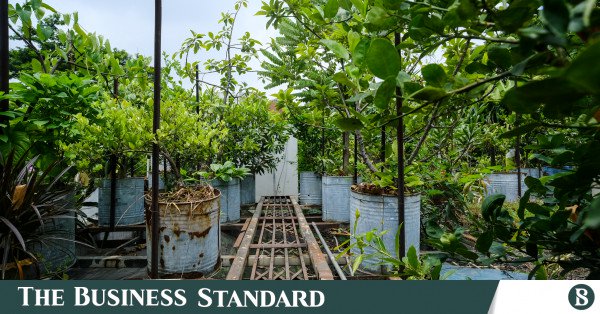[ad_1]
Urban agriculture is an essential component of urban planning. Rooftop farming training in Sher-E-Bangla agricultural university, which now suffers from a lack of funds, is possibly the best route to turn this city into a healthy one
For Ferdous Ara Chowdhury, living around a green landscape is an integral part of her existence. Her ancestral home in Gaibandha was cocooned in foliage and trees. It wasn’t until 2004 that she finally built her own abode in Dhanmondi and designed her rooftop in a way to accommodate planting of a lot of trees.
A doctor by profession, Ferdous didn’t need any training to master gardening or farming. As it turns out, her green thumb is more than enough for the job. And it was her sheer love for plants that jump-started her journey in rooftop farming and gardening, which continues for more than 18 years now.
Infographic: TBS
“> 
Infographic: TBS
“This [her love for plants] has such an impact on me that when I was a medical student in the 1990s, I had a wall of indoor plants in my hostel room,” Ferdous Ara enthusiastically recalled, adding “My brother was an architect who had worked in the United States and he took inspiration from international practices and designed my rooftop so that the gardening doesn’t harm the building”.
Currently, she has almost 2,000 plants of fruits, flowers and vegetables spread out over three to four roofs on different floors at the Dhanmondi residential building she lives in.
In 2018, Ferdous Ara got an opportunity to take part in a training session organised by the agricultural botany department of Sher-E-Bangla agricultural university.
Illustration: TBS
“> 
Illustration: TBS
“It was a day-long training session where we were taught the basics of rooftop gardening: about soil composition, pesticides, on how to source better seeds, plant breeding, etc. I felt these sessions are necessary for people living in urban areas, because in the last 18 years, I have realised we lack skill and knowledge about sourcing in the city,” explained Ferdous.
Like Ferdous, more than 200 city dwellers – nursery owners, fertiliser and seed suppliers and building owners – were trained in seven batches in 2018. The project was designed by three professors, Dr Mahbub Islam, Dr Kamal Uddin Ahmed, Dr Md Ashabul Haque; and an MS student of the agricultural botany department of the university Shahidul Islam. The training was sponsored by Islamic Leaf Worldwide Bangladesh, a non-government organisation that works with rural agriculture in Bangladesh.
“It ended in 2018, but even after that, we used to get many calls from people who own or want to build rooftop gardens. They even visited our office for information and solutions,” said Dr Mahbub.
But due to the lack of sponsors or investment, they cannot continue the training as it takes at least Tk40,000 to design a model rooftop garden of 1000-1200 sq feet.
“I feel we need more training on urban agriculture, at least once a year, to know about newer and updated technologies and plant varieties. But unfortunately, there is no such place in Dhaka. All we have to do is rely on local nursery owners,” Ferdous Ara said.
Urban farming: A repository of environmental and food solutions
Urban agriculture is an essential component of urban planning. A healthy city requires a substantial amount of bare land and water bodies. But alas, Dhaka city is void of such spaces.
“In the year 1990, 306.4 sq kilometre Dhaka city had a vegetation of 15%, which has now reduced to less than 6%,” said Dr Mahbub Islam, adding, “And not just that, the average annual temperature has also risen 5-7% since 1990. On the other hand, the population is growing and so is pollution.”
Photo: Saqlain Rizve
“> 
Photo: Saqlain Rizve
According to Dr Mahbub, advanced nations have implemented laws for urban agriculture to reduce pollution and also ensure food safety. For example, Toronto City Council enacted a comprehensive ‘Green Roof’ by-law in 2006 that says a portion of the roofs of new residential, commercial and institutional buildings must be covered with trees.
The United States has introduced a rating system for commercial buildings called ‘Leadership in Energy and Environmental Design’ which mandates rooftop greening and rainwater harvesting systems to compensate for environmental and green damage caused by building construction.
Singapore has taken initiatives to meet the demand for essential vegetables through sky-farming [gardening done on skyscrapers] to ensure urban agriculture and greening; the country has even launched a government agency called ‘Urban Redevelopment Authority.’
“Urban farming in these cities have been able to meet the need for more than 30% of fresh vegetables,” Dr Mahbub said.
In 2018, Rajuk conducted a survey inside Dhaka from January-July where they found that there are 204,106 buildings in 1528 square kilometres of land. Meanwhile, there are only a handful of buildings which host rooftop gardens.
[ad_2]
Source link
